
Click on image for larger, hi-res image (2630x916 pixels, 413KB). The smaller picture above appears approximately actual size on my monitor. The rule is the common 10" size, meaning the scales were approximately 10" long.
Before the common household had any digital computers or even electronic calculators, engineers used slide rules as analog calculators. The Empire State building, Golden Gate bridge, aircraft and early spacecraft, even the F-16, were designed using slide rules; so they definitely were a serious tool engineers depended on heavily.
My dad had a poor-quality slide rule when I was a kid but I thought it was really cool, and he let me take it to school starting in 7th grade. The other kids said it was cheating, but the teacher recognized the value and what kind of occupation I was headed for, and didn't just tolerate it, but even seemed to encourage it a bit.
Soon after, I would go to the supermarket with my mom and push shopping carts back into the store to get S&H Green Stamps (remember those?). There were no slide rules in the S&H catalog, but my mom enjoyed buying household things from the catalog and rewarded me with a Pickett N902-ES simplex trig all-metal slide rule (shown below), bought at the supermarket itself. I think it cost $4.49 back then, the equivalent of $29 in 2024. I took good care of it (as you can tell even from the case) and it got me through high school and college technical classes, even though by the end of my time in high school everyone else was using calculators. I had a calc, but it didn't have nearly as many functions as the slide rule.

Click on image for larger, hi-res image (2630x916 pixels, 413KB). The smaller picture above appears approximately actual size on my
monitor. The rule is the common 10" size, meaning the scales were approximately 10" long.
A value of the slide rule is that it helps the user to understand number relations better. I do log conversions for decibels in my head quickly, thanks mostly to having used the slide rule years ago. The slide rule is not a speed liability for someone who's proficient at it, and the three to four significant figures it gave were plenty adequate for calculating circuit component values as I wanted, especially since the components' tolerance was usually 5%, nowhere near as accurate as the slide rule is.
I didn't get serious about a calculator until I started wanting something programmable. The slide rule couldn't compete in that
area. I wanted to do things that took thousands of loop iterations. Programmable calculators were slow, doing about ten operations
per second; but if you could let it work on something while you got lunch or slept all night, it could do more than you'd ever live long enough to
do by hand, and it never made a mistake (as long as your program didn't have any bugs in it). My first programmable calculator, and first
scientific one too, was a TI-58c which I bought at Jewelcor (remember those?) in the end of 1981 for a hair under $100, approximately equivalent
to $347 in 2024. The short story of how I got into using the HP-41 for controlling equipment, and then into workbench computers, is
here. Hopefully you'll find it entertaining and interesting.
My grandfather gave me his Keuffel & Esser N4080-3S log log duplex trig slide rule about the time I quit using slide rules regularly. (It would have been great to have it ten years earlier!) The "S" at the end means it came with the stitched leather case. The 4080 had angles marked in degrees, minutes, and tenths of minutes (not in seconds-- go figure), whereas the 4081 had them in decimal degrees. The serial number indicates that it was made in 1952, and the 1953 price list has it at $25.50, or around $300 in 2024 dollars. Here's the front:

Click on image for larger, hi-res image (2798x711 pixels, 377KB). The smaller picture above appears approximately actual size on my
monitor. The rule is the common 10" size, meaning the scales were approximately 10" long.
And the back:

Click on image for larger, hi-res image (2798x711 pixels, 377KB). The smaller picture above appears approximately actual size on my
monitor.
It has a nice leather case
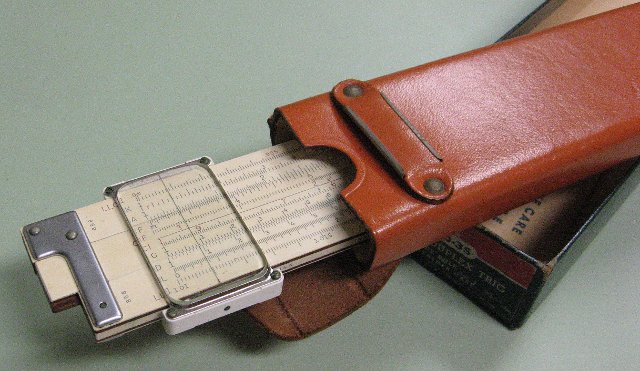
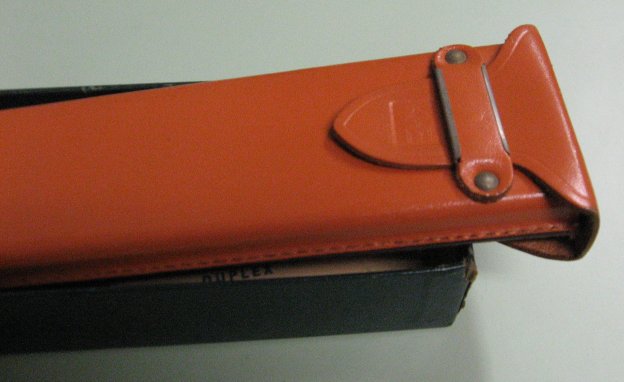
and I still have the box:
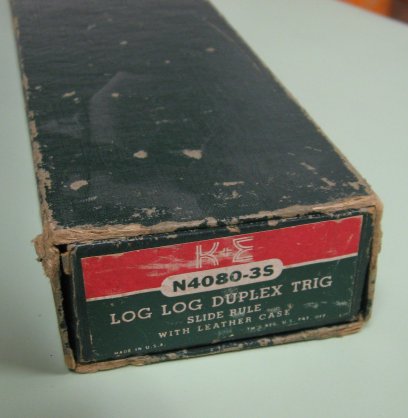
and I have the teensy care-and-feeding manual that came with it.
Also at about the same time, I saw this SIC 4500 4" slide rule in a stationers store, yellowed across most of the front from being in the display case in the sun for years. By then calculators had taken hold and pushed the slide rules out, so I'm sure I was the last customer to ever buy a slide rule from that stationers. 4" refers to the length of the scales. Most pocket slide rules were 5", not 4", so I feel lucky to have this. The case, which seems to be a low-quality genuine leather, has a pocket clip:
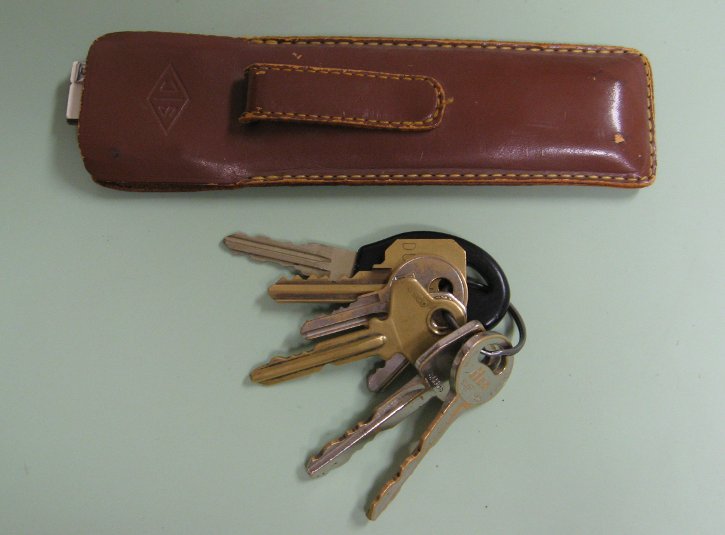
Here's the badly yellowed front:
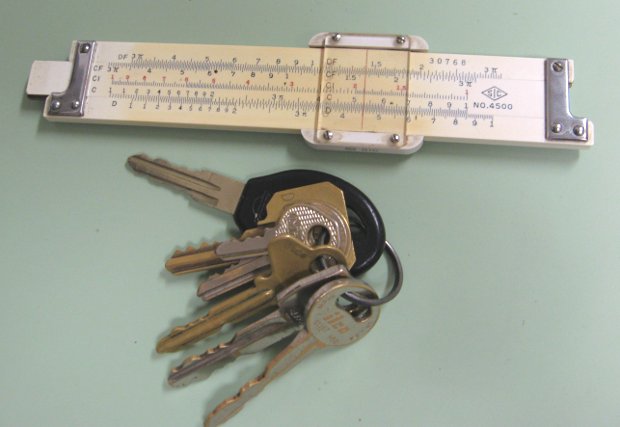
Click on image for larger, hi-res image (1209x274 pixels, 81KB). The smaller picture above appears approximately actual size on my
monitor. The scales are approximately 4" long.
and the back:
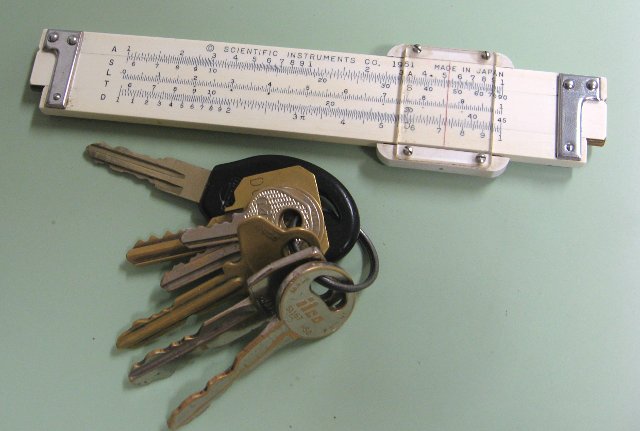
Click on image for larger, hi-res image (1210x284 pixels, 84KB).
In Jan 2016, I found out the same grandfather who gave me the nice 10" K&E above also gave my dad a tiny 4" Frederick Post model 1441 bamboo rule with a magnifying cursor, and my dad gave it to me. Although its scales are about the same length as the pocket slide rule above, its overall width and length are actually about 20% less.
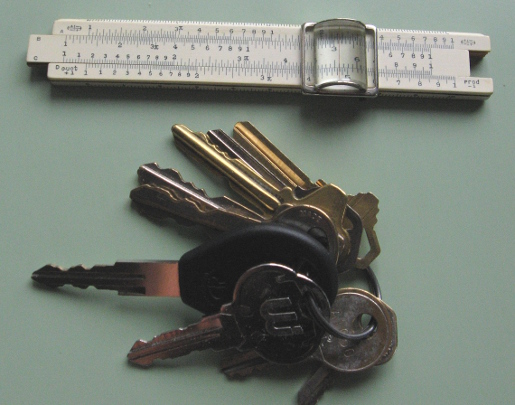
Click on image for larger, hi-res image (1200x311 pixels, 81KB). The smaller picture above appears approximately actual size on my
monitor.
Here it is with the slide turned over to show the common-log and trig scales:

Click on image for larger, hi-res image (1200x329 pixels, 81KB). The smaller picture above again appears approximately actual size on my
monitor. Clicking on it gives the big picture. You will be able to see the inches scale along the top edge. Note that the S
scale is not the normal, but instead you read the sines out on the A scale instead of the D, so there's less resolution but
a wider range. I'd say the wider range is hardly the greater need, as normally, below 5.74° (the arcsine of .1), it becomes quite linear, you can
just divide the number by 57.4 to get the sine, or as you get closer to .01, divide the input number by 57.3 (the number of degrees in a radian). This
one does use minutes instead of tenths of decimal degrees though. If you are slide-rule literate, you'll know how to get cosines, arc-cosines, and
arc-sines from there.
The bottom edge has cm:

Click on image for larger, hi-res image (1200x270 pixels, 81KB). The smaller picture above appears approximately actual size on my
monitor. This one also shows the thickness of the magnifier on the cursor.
Here's the leather case:

and the back:

At the end of this page, Eric says about it, "The smallest functional slide rule
I've ever seen! [...] narrow the date to around 1949-1951 [...] Although a bit too small to really be all that useful in everyday life,
this rule probably attracts more attention in my collection than any other! Frankly, it's just too cute for words!"
In December 2024, I was reminded
on the MoHPC HP calculator forum that Concise Co. Ltd. in Japan is still making and selling circular slide rules. I didn't have one, and have
never seen a general-purpose one up close; so since the price was reasonable, I bought the model 300. Ordering links are below. Here's
the front:
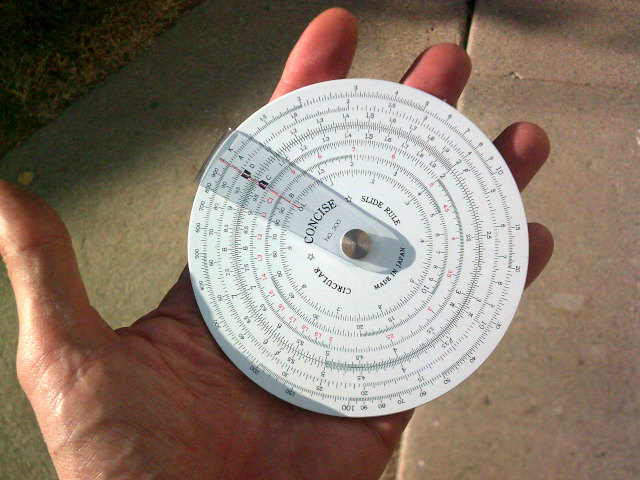
Click on image for larger, hi-res image (2048x1536 pixels, 974KB). You may need to click a second time to get the full size.
Here's the back, from Concise's own website:
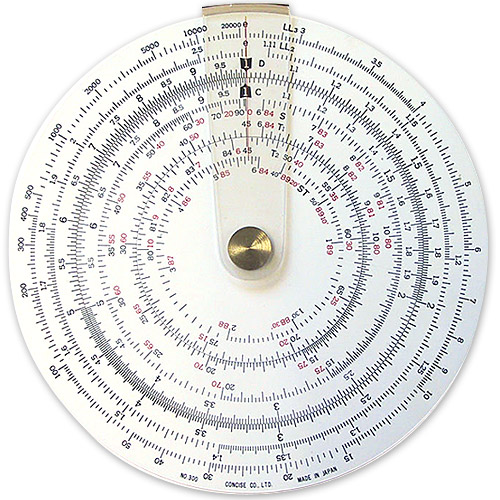
The thing I don't like about it is that it's not perfect. Note that when the 1's are lined up on the C and D scales, it's very visibly off at the other side of the circle, in the 2.5 to 3 area, and the 3.000 on the C scale points at about 3.003 on the D scale:
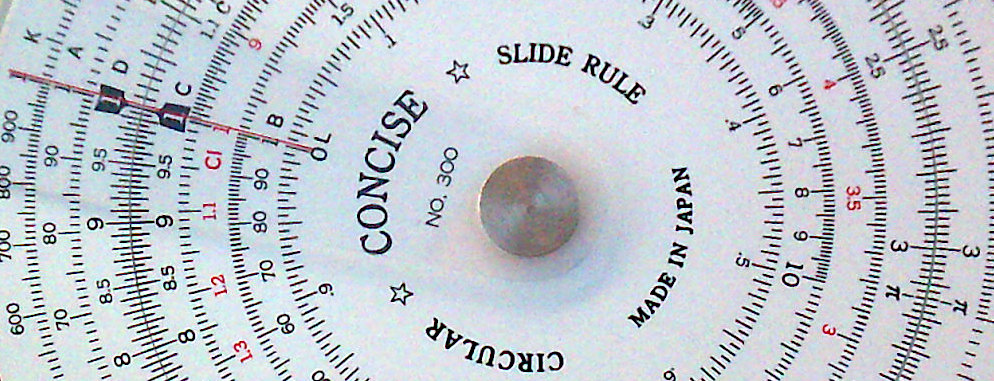
At this point it's mostly for collectors' value, since I have better rules; but if they're going to make slide rules at all, they should be at least
as accurate as good vision, which this one is definitely not.
In May of 2016, I got this tie-clasp slide rule on eBay. It is about 2-5/8" or 68mm long, and the slide and cursor do move. It works, although using it for actual calculation might require a small emergency, not just due to its size, but that the movement is rather stiff (probably to keep the slide from sliding out and getting lost), and the cursor also does not get quite all the way out to the 1's at the ends of the D scale (because there are little blobs of glue on the back to keep it from sliding off and getting lost). If you can overcome these and have good close-up vision, you can get more accuracy than you would expect from one this small.
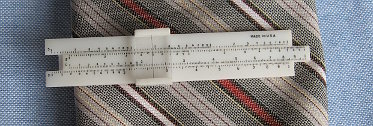
Click on image for larger, hi-res image (1400x373 pixels, 159KB). The smaller picture above appears approximately actual size on my monitor.
At the bottom are the standard C and D scales. At the top is a cube-root scale, and below it, a square-root scale. No trig or log
scales, and no folded or inverted scales. There's nothing on the back of the slide, so there's no use in turning it over. And instead
of a tongue-and-groove fit, it's slightly wider at the bottom than the top (having a trapezoidal cross-section) so it won't come out the front
accidentally; so it wouldn't fit in backwards anyway.
In the summer of 2017, I visited my uncle and his family in another state. He had basically his own private museum for his own enjoyment, and a couple of the things I saw there in the tour he gave me was an addiator and a really nice slide rule. In the spring of 2022, due to his age, he was getting rid of things and asked if there was something there I would like to have. I mentioned these two. He was apparently forgetting about the particular slide rule I had shown interest in, and he just sent this very special-purpose C-715 military flight load adjuster which I didn't know existed and I don't know anything about using it yet, having just gotten it. It seems to be for weight and balance of a bomber aircraft. This first picture is of the front, with the slide in frontwards. You can click on the picture for a higher-resolution one.
Here it is with the slide turned over. Again you can click on the picture for a higher-resolution one.
This is without the slide:
This is the back:
These don't have quite the resolution of the others further up, as the better camera I used for those quit working, and I'm using a $30 cheapie now.
Here's the addiator (although a copy, not acutal Addiator brand) for adding and subtracting. It was used by my grandfather (the same one whom two of my slide rules above came from) while he was working for Ford Motor Co. in Fargo, ND in the 1930's. I believe he was in sales. "VE-PO-AD" apparently stands for "vest-pocket adding machine." It's no thicker than a modern smart phone. The millions' place (in the range of 0-$9,999,999.99) is only incremented by carry, not by entering anything in that digit.
At my last place of work, about 1990, the engineering manager said he wanted to make a display case for his slide rule, like a fire-extinguisher case,
with a decal on the glass that says, "In case of emergency, break glass" (although it would actually be openable). Maybe I should have a wood-worker
friend make a case like that for me!
Related to the slide rule is the Smith chart which I had to get cozy with when
I was working in applications engineering at a VHF/UHF power-transistor manufacturer in the mid-1980's. By then all the engineers in the lab had
calculators of course, and most of them had HP-41's; but the paper Smith chart was still necessary and gave a quick way to calculate matching
networks and other things. Nomographs were used also. These were
commonly in engineering books, and allowed calculating various functions with just a straight edge. And, somewhere I have a circular flight calculator
will add here if I ever find it. It's not the famous E6B, but a cheaper, smaller one.
my slide-rule bookmarks: (Many of the links had gone dead, so on 8/4/20, I dug up the latest copies I could find on archive.org to link to.)
Concise Co., LTD.'s circular slide rules can be ordered
on Amazon. The Amazon page says they're not discontinued, and they were first available in 2016.
Professor Herning's YouTube channel: lots of slide-rule videos!
HP Museum: calculators before digital
Miguel Ramirez-Villa's slide-rule history page
some history on
the manufacture and marketing of slide rules
online virtual slide rule
new Faber-Castell slide rules sold until nearly 2020, up to 20" (The site is in German, and the link goes to an archived copy)
K&E slide-rule documents
Slide Rule Universe
International Slide Rule Museum
International Slide Rule Museum slide rule lessons
Rod Lovett's slide rules
Chris Osburn's slide-rule index (archived copy)
Mark's slide rules (archived copy)
Mark's cursor magnifiers (archived page)
Dietzgen N1725 hi-res image of one of the finest slide rules ever made (archived copy)
Greg Scott's slide-rule manuals (archived copy)
Eric's slide-rule site
The Slide Rule Trading Company (Paul Ross) includes repair parts
Oughtred Society (They have a facebook page too, at
https://www.facebook.com/The-Oughtred-Society-221954911183931/
The Blundell vector slide rule for complex numbers
David Crate's Quality Slide Rules
Gilai Collectibles slide rules and related mechanical calculating devices
Jay Francis, the slide-rule guy: slide rules for sale (archived copy)
Atsushi Tomozawa's slide rules
Prof. Dr. Jörn Lütjens' slide-rule museum (archived copy)
Giovanni Breda's slide rules
calculators.de slide rules (click on the little slide rule picture not far from the bottom)
How does the Analon work? (article in the Journal of the Oughtred Society)
Dutch Circle of Slide Rule Collectors, including: